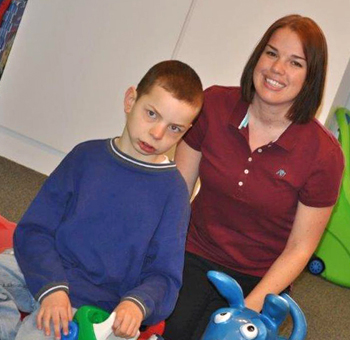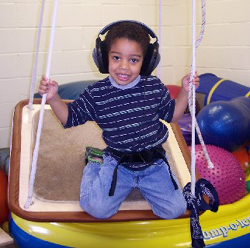
|
Pediatric Occupational, Physical, ABA/Behavioral, Feeding, Speech, and Language Therapies Main Clinic: 931-372-2567 1445 East 10th Street Cookeville, TN 38501 Email: [email protected] HIPAA Secure Email: [email protected] Fax: (931) 372-2572 ABA Clinic: 931-201-9534 400 Dubois Road Cookeville, TN 38501 Email: [email protected] Please call today to get started! Most insurances accepted! |

|
| Who needs therapy? | SE HABLA ESPAÑOL |
Therapeutic Listening Program

WHAT IS... THERAPEUTIC LISTENING ?
Therapeutic Listening was developed by Occupational Therapists Sheila Frick, OTR/L and Colleen Hacker, OTR/L and uses sound training in combination with sensory integrative techniques, which emphasize vestibular stimulation and postural movement strategies and allow therapists to approach the auditory and vestibular system directly. Sound training uses electronically altered music that has been designed to produce specific effects on listening skills when the child follows a prescribed program.
Listening skill difficulties are the inability to accurately perceive, process and respond to sounds and are often found to be an integral part of other perceptual, motor, attention and learning difficulties affecting a large number of our children. Therefore, listening becomes a function of our whole body, not just our ear. Hearing, a function of the ear, is passive and does not involve the direction of attention to sound. Sound is received by the ear and passed along like a microphone. Listening is active and requires the desire to communicate and the ability to focus the ear on certain sounds selected for discrimination and interpretation.
HISTORY USED TO DEVELOP THERAPEUTIC LISTENING:
Therapeutic Listening integrates a number of electronically altered compact disc, based on the ideas and technology created by Alfred Tomatis, Guy Berard and Ingo Steinback, within a sensory integrative frame of reference.
Tomatis developed his theory in regard to the development of hearing in utero and the impact of an auditory stimulus on all aspects of development including movement processing. He recognized the sensory integrative value of an auditory stimulus.
Dr. Guy Berard trained and worked with Dr. Tomatis. Berard developed his own device and protocol to reduce the time required to produce results. He emphasized the auditory stimulus impact on behavior and language.
Ingo Steinback was influenced by Dr. Tomatis. He developed Samonas sound therapy which is based on the principles of music therapy in accordance with development aspects and natural laws of physics related to sound. He emphasizes the global impact of specific auditory stimulus on physical, emotional, and energetic development.
WHO CAN BENEFIT FROM THERAPEUTIC LISTENING?
- Has difficulty understanding speech in noisy situations
- Has trouble hearing in groups
- Has trouble listening
- Becomes anxious or stressed when required to listen
- Is easily distracted
- Has difficulty following directions
- Seems to hear, but not understand what people say
- Has trouble remembering what people say
- Has poor speech or language skills
- Has poor reading or phonics skills
- Has poor spelling skills
- Discrepancy between verbal and performance scores and IQ tests
- Has impulsive behavior
- Is disorganized
- Has poor peer relations
- Has poor self-esteem
HOW THERAPEUTIC LISTENING WORKS:
The sound stimulation used in Therapeutic Listening appears to set up the nervous system, preparing ground for emergent skills. The music causes the muscles in the middle ear to contract, helping to discriminate and modulate sound input. In addition, there are tiny bones in the middle ear that vibrate when sound is provided, stimulating the movement (vestibular) and hearing (auditory) sensory receptors in the inner ear. This sensory information is sent throughout the central nervous system causing a multitude of reactions.
There are four nerves, which are impacted by sound therapy and travel from the inner ear to the brain and back to other parts of our body. For example, when providing sound therapy you may stimulate the facial nerve. The facial nerve innervates the muscle in the middle ear as well as the muscle of facial expression. Along with this nerve also travels the glossopharyngeal nerve, which controls the motor components of one's voice. Therefore, the muscles of the ear, which are designed to extract the human voice from a noisy background (listening) are linked with the muscles of facial expression and voice production. When you are talking with someone you rely on the non-verbal facial expressions of the person who is listening to you. So, again these same muscles are necessary for producing clear articulation and for hearing accurately and efficiently. So, through the use of sound therapy, such as Therapeutic Listening, you are stimulating the muscles of the ear as well as the muscles of the mouth, because the nerves that innervate these muscles are the same nerves.
DESCRIPTION OF EQUIPMENT USED:
Therapeutic Listening consists of a series of CD's prescribed specifically for each child over specifically designed headphones and work on a variety of skills. Listening time consists of 2 times a day, each for 30 minutes, with a minimum of 3 hours between listening times. The CD's are electronically altered or passed through a high-low filter. This means that the frequencies at which the sounds are heard vary. Some CD's jump from very high frequencies to very low frequencies and back and other CD's do the same, but the variance is much less and therefore not as intensive for the listener. Here are some examples of CD's and the skills that are being worked on:
- EASE 1 and 2: hypersensitivity to sound, movement and/or touch or defensive responses to sensory input in general
- Mozart for Modulation: supports organized body movement, attention within the environment, active engagement, language
- Kidz Jamz (Grape): helps with postural organization, sensory modulation and attention difficulties
- Vivaldi for Modulation: supports focus and concentration, supports suck-swallow-breath, heart rate and respiration, improves processing of auditory input in complex auditory environments.
A few of the FUNCTIONAL OUTCOMES OF THERAPEUTIC LISTENING ON THE CHILD:
- Decreased tactile hypersensitivity or defensiveness
- Decreased oral hypersensitivity with increased exploration and acceptance of different foods
- Improved self-regulatory behavior such as a more regulated sleep cycle, more regulated hunger thirst cycle, more regulated such-swallow-breathe pattern, more regulated respiratory control and decreased stress
- Improved balance
- Improved coordination of movement within the environment
- Increased postural organization
- Increased motor skills, both gross and fine
- Improved bilateral motor patterns
- "Emergence" of motor planning
- Improved spatial-temporal organization
- Improved handwriting
- Improved visual-motor skills
- Improved timing of motor execution
- Increased and more elaborate social interactions, with better "timing"
- Discrimination of the dimensionality and directionality of spatial concepts
- Improved components of communication such as greater range of non-verbal communication, improved/clearer articulation, greater emotional and verbal expression and improvements in pragmatic language
If your child is actively involved in clinic OT services at Center of Development, we will usually attempt TL during therapy sessions as part of their therapy needs. Once they can tolerate this input for 30 minutes during therapy, we will suggest that this be taken home and done daily. The cost is minimal and only a deposit is required if in weekly therapies.
Please contact us for more information
Parts adapted from "Listening with the Whole Body" by Sheila M. Frick, OTR/L, and Colleen Hacker, MS. OTR/L Course and Book Notes Heidi Clopton, OTR/L
Using Colors with Non-Verbal and Low-Verbalization
Noise Sensitivity and Magnesium
Transitions and Related Behaviors
Central Auditory Processing Disorder
Classroon Management Strategies for Children with Auditory Processing Disorders
Site empowered by
WebOnTheFly